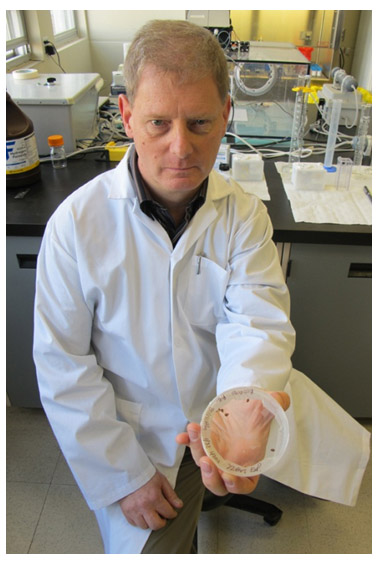Vapor-based fumigant system could prove useful in disinfecting microbiology labs, clinical labs, and histology labs
There’s a new technology that bears great promise for improving existing methods of disinfecting hospital rooms and health facilities, including clinical laboratories. This pioneering work was developed as part of a collaboration involving infection control expert Dick Zoutman, M.D., FRCPC, who is affiliated with Queen’s University of Kingston, Ontario, Canada.
This technology is a vapor-based fumigant system and is coming to market with the name AsepticSure. It will be sold by Medizone International, Inc.. The invention makes a strong argument for changing the way hospital rooms and other healthcare facilities are disinfected.
Cleaning Methods Used to Disinfect Hospital Rooms Can Prevent Deaths
Of the new system, Zoutman said,“This is the future because many hospital deaths are preventable with better cleaning methods. It has been reported that more than 100,000 people in North America die every year due to hospital acquired infections at a cost of $30 billion. That is 100,000 people every year who are dying from largely preventable infections” He was quoted in a press release issued by Queens University.
Zoutman’s association with this disinfection system comes as no surprise. First and foremost is Zoutman’s belief that there is a better way. In 2008, he did a follow-up survey to a 1999 Public Health Agency of Canada study. This study was conducted prior to the infamous Clostridium difficile (C diff) crisis in Quebec in 2002-2004 and the Severe Acute Respiratory Syndrome (SARS) outbreak in Ontario in 2003. Microbiologists and pathologists worldwide remember these two incidents well.

Infection control expert Dick Zoutman, M.D., FRCPC, of Queen’s University in Canada, describes a new disinfection technique, AsepticSure, as being similar to what we now know nature uses to kill bacteria in humans. Zoutman collaborated with Dr. Michael Shannon of Medizone International in developing the technique. (Photo by SiliconInvestor.com.)
In this follow-up report, Zoutman indicated that—despite a focused infection control effort in Canadian hospitals after the SARS scare—resistant bacterial infections were multiplying faster than had been shown in the 1999 study. In 1999, researchers estimated that—of the 250,000 patients with infected surgical wounds, blood infections, and antibiotic-resistant organisms while in hospital—8,000 would die annually.
Zoutman determined that, between the years 1999 and the 2008, methicillin-resistant Staphylococcus aureus (MRSA) infections more than doubled in Canada. Further, vancomycin-resistant enterococcus (VRE) was found in 77% more hospitals. Because of changes made after the Canadian C diff and SARS crises, Zoutman noted in a press release that the “combination of more infection control practitioners and activity, but also more bugs, has not taken us where we want to be.”
In reaction to these findings, Zoutman set out to look for ways to improve infection control. He began collaborating with Michael Shannon, M.A., M.Sc., President of Medizone International. They initiated research. The test organisms used during the disinfection system’s development included MRSA, VRE, Escherichia coli, Pseudomonas aeruginosa, C diff, and Bacillus subtilis spores.
These infectious agents were dried onto steel discs or cotton gauze pads. Zoutman, Shannon and their research team looked at different disinfection methods. They settled on a method which used a specific ozone from Medizone. When this ozone was combined with hydrogen peroxide vapor, this particular mixture both cleans and sterilizes. These findings were published by the American Journal of Infection Control.
Zoutman explained to reporters that the technique is similar to what we now know nature uses to kill bacteria in humans. When an antibody attacks a germ, it generates ozone and a minute amount of hydrogen peroxide, producing a new highly reactive compound that is profoundly lethal against bacteria, viruses, and mold. “It works well for Mother Nature and is working very well for us,” said Zoutman.
AsepticSure completely sterilizes everything in hospital rooms: floors, walls, drapes, mattresses, chairs, and other surfaces. The disinfection system is more effective in killing bacteria than wiping down a room—a common practice of only a few years ago which was found to simply spread contamination.
Clinical Laboratories Would Benefit From New Disinfection System
This new system for disinfection shows promise for use in medical laboratories. Microbiologists and pathologists may recall 2011’s outbreak of salmonella poisoning in clinical and teaching microbiology laboratories in 35 states.
This episode began in August 2010 and lasted through early 2011. During this time, more than 73 people were sickened by the bacteria. Some were infected by a strain of Salmonella Typhimurium sold commercially for laboratory use, according to the Centers for Disease Control and Prevention (CDC). This story was reported by MSNBC.
A study of 32 cases found that 60% of ill patients were exposed to microbiology laboratories in the week before their illness began, compared with 2% of people in a control group. Those affected included medical laboratory students and employees, as well as children who lived in households of people who studied or worked at the laboratories.
In the wake of this event, officials from the CDC warned that bacteria used in medical laboratories can be transmitted through contaminated lab coats, pens, notebooks, car keys, and other items brought into the labs. Thus, the new disinfection method developed by Zoutman and Shannon may turn out to be an effective solution in clinical laboratories, histopathology laboratories, and other medical laboratory settings.
Finally, microbiology departments in many hospital laboratories around the United States have regularly reported that when the ties worn by doctors in their facilities were tested, it was common to find bacteria that could spread disease. There is no word yet, on whether this new vapor-based system might be useful in disinfecting doctor’s ties!
—Carren Bersch
Related Information:
New Disinfection Technique Could Revolutionize Hospital Room Cleaning
Guideline for Disinfection and Sterilization in Healthcare Facilities, 2008



